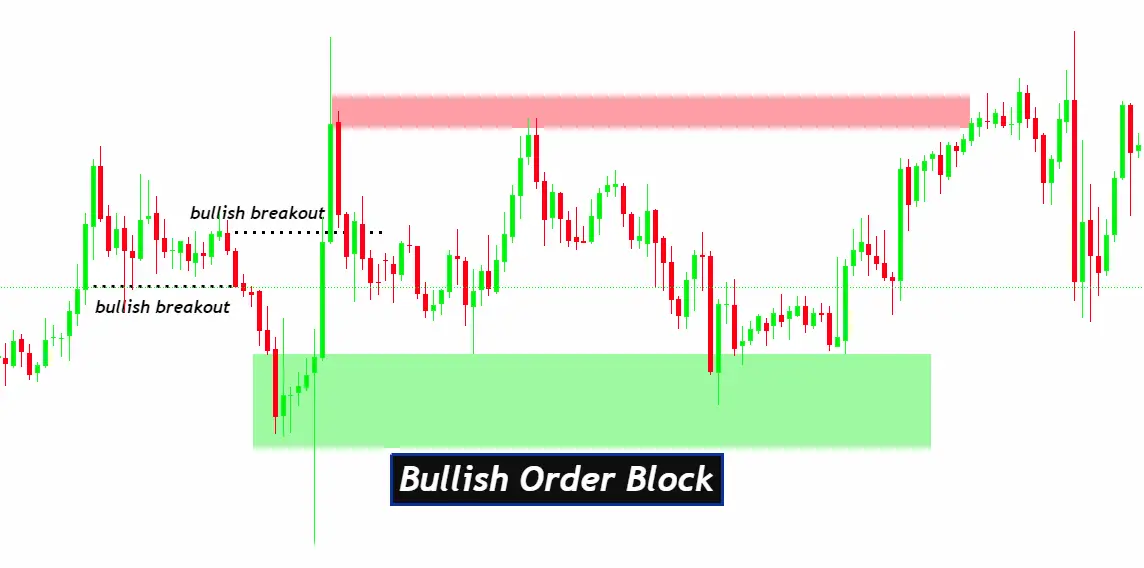What Is a Bullish Order Block?
A Bullish Order Block is a specific area on the price chart where significant buying activity occurred in the past, indicating strong interest from buyers. It often precedes upward price movements, making it a key area watched by traders.
How Bullish Order Blocks Form
- Accumulation of Buy Orders: These blocks form during periods when institutional investors or large traders place substantial buy orders, driving the price up.
- Retracement Zones: Typically, they appear after a noticeable downtrend or a pullback, signaling a potential reversal to an uptrend.
The Role of Bullish Order Blocks in Market Trends
- Indicators of Institutional Interest: These blocks suggest areas where big players are likely to enter the market again, providing a clue about future price movements.
- Support Levels: They often act as strong support levels, where price finds it difficult to break below, leading to bullish reversals.
- Momentum Shifts: Identifying these blocks can help traders spot early signs of momentum shifts from bearish to bullish trends.
Understanding bullish order blocks allows traders to better predict market movements and make informed decisions. By identifying these key areas, traders can align their strategies with the activities of large market participants, improving their chances of success in the volatile world of trading.
Identifying Bullish Order Blocks
Identifying Bullish Order Blocks is a crucial skill for traders aiming to capitalize on potential upward movements in the market. This section outlines how to spot these pivotal areas on price charts and distinguish them from other price signals.
Key Indicators to Look For
- Previous Strong Buying Areas: Look for areas on the chart where price made a significant move upward after a period of consolidation or retracement.
- Increased Volume: A noticeable spike in trading volume often accompanies the formation of a bullish order block, indicating strong buying interest.
Chart Patterns and Bullish Order Blocks
- Consolidation Before a Breakout: Bullish order blocks can form during periods of consolidation, right before the price breaks out upward.
- Retest of Breakout Areas: These blocks are often retested after a breakout, serving as a confirmation of the bullish sentiment.

The Difference Between Bullish Order Blocks and Other Price Signals
- Not Just Any Support Zone: Unlike regular support zones, bullish order blocks are specifically associated with a historical influx of buy orders from significant market players.
- More Than Just a Candlestick Pattern: While certain candlestick patterns may indicate buying interest, bullish order blocks are identified by combining price action with volume and historical context.
Identifying bullish order blocks involves a keen eye for detail and an understanding of market dynamics. Traders who master this skill can better position themselves to enter trades with higher probabilities of success, leveraging the momentum generated by the market’s most influential participants.
How to Trade Bullish Order Blocks
Trading Bullish Order Blocks effectively requires a strategic approach that combines entry, risk management, and exit strategies. Here’s how traders can leverage these blocks for potential profit while minimizing risk.
Entry Strategies
- Wait for a Retest: Enter a trade when the price retests the bullish order block area, confirming support.
- Look for Confirmation Signals: Use additional indicators or candlestick patterns as confirmation before entering.
Risk Management
- Setting Stop Losses: Place stop losses just below the bullish order block to protect against unexpected reversals.
- Determining Position Size: Adjust position size based on the distance to your stop loss to manage the risk effectively.
Exit Strategies
- Taking Profits: Set take-profit levels at previous resistance levels or use a trailing stop to maximize gains.
- Signs of Reversal: Be ready to exit if price action indicates a reversal, such as breaking below the bullish order block with increased volume.
Tips and Best Practices
- Monitor Economic News: Stay informed about economic events that could influence market sentiment and affect the strength of order blocks.
- Use Technical Analysis Tools: Incorporate other technical tools like moving averages or RSI to validate your trading decisions.
- Practice on a Demo Account: Before applying these strategies with real money, practice in a demo account to gain experience and confidence.
Trading bullish order blocks involves recognizing these key areas, executing trades based on solid evidence of support, and managing risks carefully. By following these strategies, traders can improve their chances of success in the fast-paced trading environment.
Conclusion
In conclusion, understanding and trading bullish order blocks can significantly enhance a trader’s ability to spot potential opportunities in the market. These blocks represent areas where significant buying has occurred, often leading to upward price movements. By identifying these zones, traders can align their strategies with the momentum of large market players.
Key takeaways include the importance of recognizing the formation and characteristics of bullish order blocks, employing strategic entry and exit points, and adhering to strict risk management practices. Additionally, integrating other technical analysis tools and staying informed about market news can provide further validation for trading decisions.
Practice and patience are essential. Starting with a demo account to refine your ability to identify and trade bullish order blocks without financial risk is advisable. As you gain confidence and experience, you can transition to live trading with an informed and disciplined approach.
This guide underscores the significance of bullish order blocks in trading strategies, offering a foundation for traders to build upon. With diligence and continuous learning, traders can leverage these insights to navigate the markets more effectively, aiming for successful outcomes in their trading endeavors.


